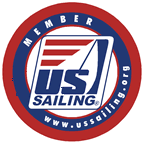By Tod Bassham
How to apply the new 2013-16 Racing Rules of Sailing (RRS) to the particular conditions of the big ditch we call the Columbia River was a hot topic of discussion at the North U Rules and Tactics Seminar February 23, 2013, in Portland. Taught by famed champion sailor and Senior US Sailing Judge Dave Perry, the seminar introduced the new rules and tactical applications to a group of approximately 80 local racers.
OCSA (Oregon Corinthian Sailing Association) hosted and generously subsidized the seminar, with the support of its constituent local racing clubs. OCSA arranged to bring Mr. Perry to Portland, allowing OCSA members and local racers to attend for about half the usual North U seminar price. Even better, the discounted seminar price included full US Sailing membership as well.
As an added bonus, the program actually began the evening before, when Perry stepped off the plane and launched into a mock protest hearing featuring three local judges – all members of OCSA’s Protest Committee – and three volunteers role-playing a disputed leeward mark rounding scenario. Perry offered tips and commentary about the protest hearing process, and walked the panel and participants through the three parts of a hearing: validation of the protest, evidence, and decision. He reminded the 30 local racers in attendance that the game of sailing is uniquely self-refereeing, and encouraged every racer to invoke the protest process as needed to maintain the integrity of the sport.
The next morning the crowd filled the Mt. Adams room of the Airport Sheraton as Perry began an intensive eight-hour tutorial on how to rule the course by bringing out your inner rule-geek. Fortunately, Perry is an engaging and absolutely hilarious instructor. Using chalkboards, videos, breakout sessions and boundless energy, he cut through the complexities of RSS Parts A, B and C like a Maxi starboard-tacking through a fleet of Optis.
Even Rule 18 yielded its secrets. Perry explained the 2013-16 changes to the rule, how the “game” had changed slightly. Formerly, he explained, an inside boat entitled to mark-room from an outside right-of-way boat could sail its “proper course” while at the mark, which meant it could make a wide tactical rounding if that was the speediest means of finishing. No more. Under the new rules and definitions, mark-room grants a boat only the “room to round the mark as necessary to sail the course,” i.e., a seamanlike rounding.
Further, Perry addressed the vexing question of when the right to mark-room ends. This was of particular interest given the circumstances common on the Columbia River at windward roundings, where a boat clear ahead or entitled to mark-room rounds the mark, but then stalls in the current or does a gybe-set and remains close to the mark. Perry explained that ISAF is considering this question and has not yet provided an answer, but in his opinion the ruling will be that “mark-room” grants only the right to follow a fairly narrow “path” around the mark toward the next mark. If, due to current or other circumstances, a boat is forced or chooses to wander from that narrow path, it is no longer protected by mark-room and is thereafter subject to Section A rules. In Perry’s view, “mark-room” does NOT include the right to gybe while rounding the windward mark, because the course changes associated with gybing are not “necessary to sail the course.”
Many thanks to Perry, North U, OCSA and all the volunteers for bringing educational programs of this caliber to the Portland area. Racing in the Ditch will never be the same!



